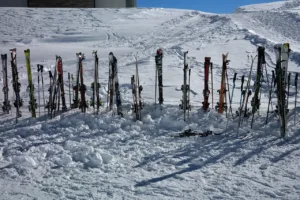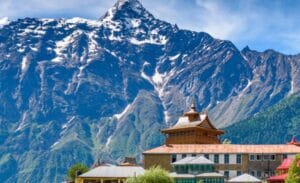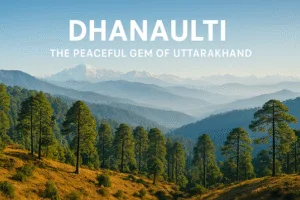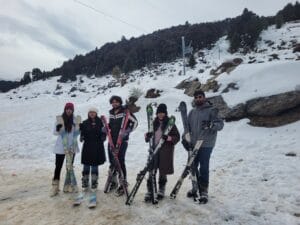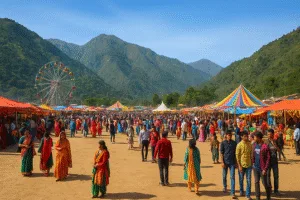Rudranath Temple – A Complete Travel & Trekking Guide

Mohit Bangari
Explore Himalaya With Me!!
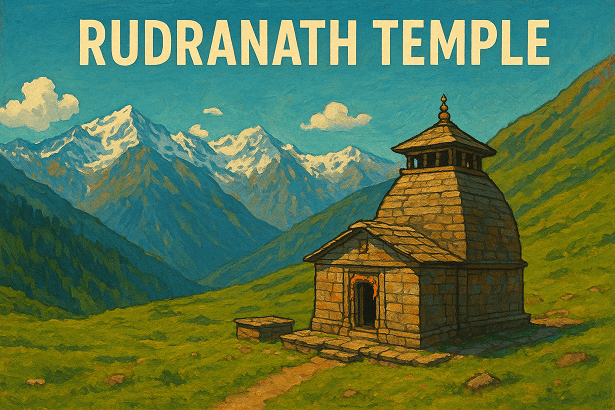
Rudranath is one of the Panch Kedar temples, where Lord Shiva is worshipped in his face form (mukha swarup). The temple is set in a natural rock cave at 3,600 m altitude, surrounded by alpine meadows and dense forests. The journey itself is an experience of silence, devotion, and pure Himalayan beauty. Unlike Kedarnath or Tungnath, here you walk through long ridges and high bugyals before reaching the shrine.
I will cover every detail – mythology, trek routes, distances, coordinates, stay, costs, and darshan tips.
Discover the divine journey of Panch Kedar – five sacred abodes of Lord Shiva nestled in the Himalayas. Learn the sacred stories, temple details, spiritual significance, and trek-wise itinerary in one detailed guide. Explore the complete pilgrimage here: https://mohitbangari.com/panch-kedar/
Table of Contents
Quick Facts
Location: Gopeshwar block, Chamoli district, Uttarakhand
Coordinates: 30.3560° N, 79.3436° E
Altitude: about 3,600 m (11,800 ft)
Deity: Lord Shiva as Rudranath (face/mukha)
Part of: Panch Kedar circuit (Kedarnath, Madhyamaheshwar, Tungnath, Rudranath, Kalpeshwar)
Main trekking routes & distances:
Sagar → Panar Bugyal → Rudranath: ~20 km one way
Mandal → Anusuya Devi → Rudranath: ~24 km one way
Urgam → Bansi Narayan → Rudranath: ~20–22 km one way
Trek difficulty: Moderate, with long ascents and ridge walks
Temple opening: May/June – Oct/Nov (depending on snowfall)
Winter seat: Gopinath Temple, Gopeshwar
Nearest road head: Sagar village (5 km from Gopeshwar)
Nearest town/market: Gopeshwar (5 km from Sagar)
Nearest airport: Dehradun (Jolly Grant, ~258 km from Gopeshwar)
Nearest railway station: Rishikesh (241 km from Gopeshwar)
Mythology and Significance
The story of Panch Kedar is deeply tied to the Mahabharata. After the Kurukshetra war, the Pandavas wanted to absolve themselves of the sin of killing their own kin. They searched for Lord Shiva, but Shiva, unwilling to forgive easily, turned into a bull (Nandi) and disappeared into the Himalayas.
The bull’s body reappeared in five different places, each worshipped as Panch Kedar:
Kedarnath: hump – I have explained Kedarnath in detail in my article click here.
Tungnath: arms – Tungnath is the world’s highest Shiva temple, you can read more click here.
Madhyamaheshwar: navel and stomach – I have already shared my experience and guide click here.
Rudranath: face (mukha).
Kalpeshwar: hair (jata) – for Kalpeshwar Mahadev details click here.
At Rudranath, Lord Shiva’s face form is worshipped in a natural stone cave. The name “Rudranath” means the fierce face of Rudra (Shiva). The temple is considered powerful for washing away anger, ego, and sins of past actions.
The surrounding area also has deep significance:
Pitradhar (ancestor ridge): where pilgrims offer pind-daan for ancestors.
Suryakund, Chandrakund, Tarakund: sacred water kunds.
Vaitarini river: believed to help souls cross to liberation.
Panar Bugyal: holy meadow where gods are said to rest.
Every year, a fair in Shravan month gathers villagers and devotees with folk music and worship.
Trek Routes and Distances
1) Sagar – Panar Bugyal – Pitradhar – Rudranath (most popular)
Base point: Sagar village (5 km from Gopeshwar, 10 km from Chamoli on NH7)
Total trek distance: ~20 km one way
Route breakdown:
Sagar → Panar Bugyal: 12 km (steep forest climb)
Panar → Pitradhar → Rudranath: 8 km (ridge walk, then descent into temple bowl)
Highlights: Beautiful meadows at Panar, Dhaukdhar cliff views, long ridge with snow peaks view (Trishul, Nanda Devi, Hathi Parvat).
2) Mandal – Anusuya Devi – Liti Bugyal – Rudranath (scenic)
Base point: Mandal village (13–14 km from Gopeshwar)
Total trek distance: ~24–26 km one way
Route breakdown:
Mandal → Anusuya Devi Temple: 5 km
Anusuya → Bugyals → Rudranath: 19–21 km
Highlights: Visit to Anusuya Mata Temple, peaceful forests, large meadows.
3) Urgam – Bansi Narayan – Rudranath (spiritual route)
Base point: Urgam valley (road turns from Helang on Badrinath highway, 12 km drive to Urgam)
Total trek distance: ~20–22 km one way
Route breakdown:
Urgam → Bansi Narayan Temple: ~10–11 km
Bansi Narayan → Rudranath: ~10–11 km
Highlights: Darshan at Kalpeshwar Temple (Panch Kedar), Bansi Narayan meadow, less crowded trail.
Tip: For most trekkers, Sagar route with a 2-night/3-day plan is best. Those who want a circuit can go Sagar → Rudranath and return via Mandal.
4) Circuit option
Some trekkers do Sagar → Rudranath → Mandal, making it a circuit trek.
Important Distances
Haridwar – Chamoli: 260 km (10–11 hrs by road)
Rishikesh – Chamoli: 241 km
Chamoli – Gopeshwar: 10 km
Gopeshwar – Sagar: 5 km
Gopeshwar – Mandal: 13 km
Helang (on Badrinath highway) – Urgam: 12 km
Urgam – Kalpeshwar Temple: 3 km walk
Rudranath – Kalpeshwar (via Urgam route): ~45–50 km trek
Suggested itineraries
Fast pilgrims (fit, used to hills)
Day 1: Gopeshwar → Sagar → trek to Panar Bugyal (camp/guest hut)
Day 2: Panar → Rudranath darshan → stay near temple (basic)
Day 3: Rudranath → Sagar (long descent) → Gopeshwar
Comfortable pace (most people)
Day 1: Gopeshwar → Sagar → Panar
Day 2: Panar → Rudranath darshan → stay near temple
Day 3: Rudranath → Panar
Day 4: Panar → Sagar/Gopeshwar
Circuit lovers
Day 1: Gopeshwar → Mandal → Anusuya Devi
Day 2: Anusuya → bugyals → Rudranath
Day 3: Rudranath → Panar
Day 4: Panar → Sagar
Temple timings & rituals (typical)
Morning aarti: around sunrise.
Evening aarti: around sunset.
Puja options: Rudrabhishek, jal abhishek, simple archana.
Local priests guide you. Offerings are simple: bel-patra, flowers, ghee, prasad. In winter, the deity shifts to Gopinath, Gopeshwar.
Stay, food, and water
Night stay options: Basic GMVN/TRH or community huts at Panar and near Rudranath. During yatra season, some dhabas put up tents.
Food: Dal-chawal, roti-sabzi, chai, Maggi, egg in some places. Keep dry fruits.
Water: Natural springs on trail; still carry 2 litres per person. Use purification drops if taking from stream.
Permits and fees
Usually no special permit. However, forest entry fee may be charged near trailhead (Sagar/Mandal) as sections fall under protected forest/wildlife zones. Keep ID proof.
Mobile network & electricity
Gopeshwar/Sagar/Mandal: Jio/Airtel work.
Panar & Rudranath: Patchy to nil. Sometimes BSNL catches on ridges.
Charging: Limited. Carry a 10,000–20,000 mAh power bank.
Difficulty & fitness
Grade: Moderate. Daily trek 8–12 km with continuous climbs.
Trail type: Forest paths, meadow ridges, rocky patches.
Who can do: Anyone with basic fitness and no acute knee/heart issues.
Prep: 3–4 weeks of brisk walk/jog (4–5 km/day), staircase climbs, light strength work.
Altitude sickness care
Hydrate well.
Climb slowly.
Avoid alcohol and smoking.
Watch for headache, nausea, unusual fatigue.
If symptoms rise, descend and rest.
What to pack (season-wise)
Clothing:
2 quick-dry T-shirts, 1 thermal set, 1 fleece, 1 padded jacket
Trek pants (2), rain jacket/poncho, rain cover for backpack
Woolen cap, sun cap, neck buff, 2–3 pairs of woolen socks
Gloves (woolen + waterproof if monsoon)
Footwear:
Good trekking shoes with grip, 1 light slipper for camps
Other:
Sunscreen, lip balm, sunglasses
Headlamp, power bank, basic medical kit
Personal mug/spoon, water bottles (2 x 1L) or hydration bag
Dry fruits, chikki, ORS
Trekking poles (very useful on descents)
Costs (indicative, per person)
Transport Rishikesh → Gopeshwar → Rishikesh: ₹1,800–3,500 (bus/shared sumo/taxi split)
Forest/entry: ₹50–₹200 approx., if applicable
Stay & food on trail: ₹800–1,500 per day (basic hut/tent + simple meals)
Guide (optional but helpful): ₹1,200–2,000 per day for group
Puja: As per wish
Darshan tips
Reach temple before noon or by evening aarti.
Carry woolens and rain cover even in summer.
Keep cash; ATMs are in Gopeshwar/Chamoli only.
Respect the silence around the sanctum. Photography may be restricted inside.
Nearby places to add
Gopinath Temple, Gopeshwar: Winter seat of Rudranath.
Anusuya Devi & Atri Muni Ashram: Peaceful forest temple.
Panar Bugyal ridge: Must watch sunrise/sunset.
Bansi Narayan Temple: High meadow shrine with grand views.
Kalpeshwar: Another Panch Kedar, road heads till Urgam.
Safety and responsible travel
Start early each day. Afternoon weather changes fast.
In monsoon, check landslide/bridge status at Gopeshwar.
Do not litter. Bring your waste back to base.
Avoid loud music on trail.
Hire local guides/porters where possible. It supports village economy.
Sample 4-day plan (from Rishikesh/Haridwar)
Day 0: Night travel to Gopeshwar
Day 1: Gopeshwar → Sagar → trek to Panar
Day 2: Panar → Rudranath darshan → stay near temple
Day 3: Rudranath → Panar → Sagar → Gopeshwar
Day 4: Return to Rishikesh/Haridwar
Panch Kedar connection (related reads)
I have already written detailed guides on Kedarnath, Madhyamaheshwar, and Tungnath–Chopta on my blog. You can read those to complete your Panch Kedar circuit planning.
FAQ’s
1) Is Rudranath trek okay for first-timers?
Yes, if you are fit and follow a slower plan. Take a guide and carry proper layers.
2) Can families do it?
Yes, many do. Keep children above 10–11 years. Plan more breaks.
3) Are ponies or porters available?
Porters often available at Sagar/Mandal in season. Ponies are rare on ridge sections.
4) Any ATM on the trail?
No. Use Gopeshwar/Chamoli ATMs before starting.
5) Network at the temple?
Mostly no. Inform family from Gopeshwar itself.
6) Can I camp anywhere?
Camp only at traditional spots like Panar and near designated dhabas. Avoid grazing grounds and water sources. Always ask locals.
7) Is monsoon trekking safe?
It is lush but tricky. Paths get slippery. Start early, carry poncho, and check weather with locals.
8) What about medical help?
Basic first aid only on trail. Keep your medicines. Nearest larger facilities are in Gopeshwar/Chamoli.
9) What is the closing date?
Usually late Oct/Nov before heavy snow. For winter darshan, visit Gopinath, Gopeshwar.
10) Can I combine Rudranath with Kalpeshwar?
Yes. Plan Urgam side entry/exit or keep an extra 1–2 days.
Conclusion
Rudranath is not just a temple, it is a place where devotion and nature walk hand in hand. The long trek, the peaceful meadows, the sound of rivers, and finally the darshan of Lord Shiva’s fierce face form give a different kind of strength. Unlike Kedarnath or Tungnath where crowd is more, Rudranath is still untouched and calm. This is why many people call it the most soulful of all Panch Kedar.
If you are planning to do Panch Kedar, Rudranath should never be missed. The journey may be tough but the blessings and beauty you receive here stay forever in heart. Combine it with nearby treks like Kalpeshwar or Madhmaheshwar, and you will feel the real spiritual charm of Himalaya.
– By Mohit Bangari
ॐ नमः शिवाय
” Ohm Namah Shivaya “
“I bow to Lord Shiva, the supreme consciousness, the inner self.”
Related Post

Mohit Bangari
Explore Himalaya With Me!!
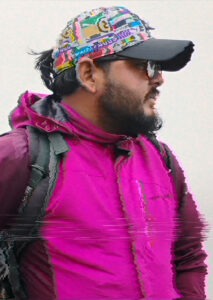

Explore the beauty and cultures of the Himalayas, from Jammu and Kashmir to Arunachal Pradesh, Tibet and Nepal. My blog shares stories, pictures, and fun articles about this amazing region. Come along on a journey where each mountain has a tale and every valley hides a treasure. Join me as I discover the magic of the mountains together.
Welcome to my Himalayan Adventure!

